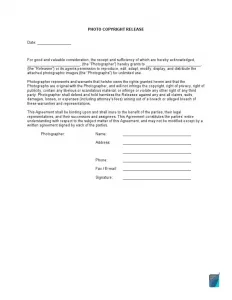Photography Copyright Release Form
Copyright protection applies to all creative acts and processes resulting in an innovative product that bears a mark of original authorship. This set of rules extends to every medium, and the medium of such works may vary significantly. However, artwork does not have to be officially reported with the United States Copyright Office to be legally protected by specific statutes. Therefore, once you create your artistic work, you are its copyright owner by default, and the lifelong security of your creative property is provided.
While the registration is unnecessary, it is advisable to notify about the copyright claim and grant the artists the ability to take legal actions if any rights infringement happens, providing compensation of attorney’s fees and legal costs. Furthermore, the validation of your rights as an artist ensures the extra-security of your unpublished works.
Today, the term “copyright release” is often applied more often, especially in photography. A photo copyright release is an authorization to copy, distribute, promote, or use in any other way the copyrighted photos at the wish of the owner. Contrary to full copyright transfer, it is a special approval granted by the copyright owner. Usually, such a photo release agreement does not have an expiration date and determines the assignment of responsibility between both parties, expressed in specific terms: the “releasor” and the “releasee.”

Build Your Document
Answer a few simple questions to make your document in minutes
Save and Print
Save progress and finish on any device, download and print anytime
Sign and Use
Your valid, lawyer-approved document is ready
When to Use Photography Copyright Release
Whether you print the photos through a processing store, exhibit, or insert them in your blog, keep in mind that the photographs may be secured by copyright. We recommend that you get acquainted with the Creative Commons (CC) organization and its general regulations for further information.
If you are a photographer or an artist who wants to share and promote creative artworks (by letting others copy and share them, too) and at the same time keep your intellectual property secured, filling out the copyright form may be a good option.
Photography Copyright Release Form Details
| Document Name | Photography Copyright Release Form |
| Other Names | Copyright Release, Copyright Release for Photographers |
| Avg. Time to Fill Out | 5 minutes |
| # of Fillable Fields | 9 |
| Available Formats | Adobe PDF |
General Steps: How to Use a Photo Copyright Release Form
When completing this form, one should feature at least the following basic details:
- Full names of both the releasor and releasee
- Necessary information about each licensed photo
- Releasor’s signature
- The actual date the agreement is signed

Filling Out a Photo Copyright Release Form
Using our in-built template, you can complete the release of liability form quickly and easily, just in several steps.
1. Do a Thorough Check-Up of Creative Commons for Free Use
You already know that not each photo is copyrighted. If you wish to use free and accessible photographs on the Internet, we strongly advise you to check the Creative Commons database in advance. Since it supports a great variety of images and photo search engines, it will not be a problem to find a suitable photo that is free to use or attribute it if needed.
2. Get in Touch with the Photo’s Owner
In case the chosen photo is under copyright, it is your duty to get in touch with the owner to specify the details of its further usage. In some cases, the author simply permits you for free, but do not always count on it and accept the copyright conditions, if there are any.
However, there might be an exception to the copyright, called the “fair use” doctrine—the one that allows free usage of copyright in a restricted and reasonable way. Fair use is a complicated legal standard that may apply to a particular case, so do not underestimate its prerequisites.
3. Give Payment or Consideration
Being a full owner of creative property, one has the right to ask for compensation. It may be paid in advance, later in the form of royalties, or specified in the discussion.
4. Get the Signature
The copyright release comes into force only after it is completed and signed by the artwork’s author. Keep in mind that the author may ask for a copy of the release, so prepare an extra one in advance.

5. Use the Photo
If permission is given and the agreement is signed, you finally have the right to use the photographs. We advise you to keep the document, though, for potential future reference.